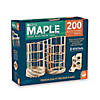How do you keep everyone engaged? That is a great question and challenge. I only have to work with them 50 minutes 1 time per week. I am not cut out to be a Kindergarten teacher.
I have finally developed a few options that work well...centers! MOVEMENT is the key.
This year, I got brave and tried some new lessons in new places. Taking 15-20 kindergarteners outside TERRIFIED me. I can barely keep track of my crew of 6 in public places like parks, stores, etc... Taking an entire class outside was scary.
The first week, I did tin foil boats as "engineers". I have made them for a first STEAM lesson most years. The first year was in a pool in the STEAM room on carpet and/or courtyard. Year 2 and 3, I used a bucket in the STEAM room which wasn't big enough. This year, I borrowed the life skill teacher's small kiddie pool. However, we moved to the butterfly garden by the school garden. It is close to the hose connection, has great teaching benches, and no one hears the joyful noise made.
It was a total success. I use the pre-cut sheets of aluminum foil from GFS (Gordon Food Service). The box is industrial size. I think the pieces are bit thin and flimsy, but they are ALL the same size with no extra work!
I did not lose any children, they learned how to try something new, and we got to enjoy the school garden.
NOW I was hooked on outdoor teaching...but week 2 is usually read "Goldilocks and the Three Bears" then do STEAM centers in the STEAM room. So I went with the normal since I was not pre-planned for another outdoor lesson. Some of our centers week 1 were the Lake Shore Learning "Goldilocks and 3 Bears" kit (from my Donor's Choose grant), gear toy, Keva Planks, writing names on dry erase boards, and big floor puzzles.
Links to products:
Lake Shore Learning Kit
Gears

Keva Planks

Week 3 was time for a new and fun outside lesson. We did BUBBLE WANDS out of pipe cleaners while talking about shapes! Make a circle bubble wand - get a circle (sphere shaped bubble). What happens when we make a triangle, square, heart shaped wands? You have to try it to find out.
A few classes planted/weeded the garden. We planted lettuce, radishes, and spinach. They desperately need more water but rain is limited. The lettuce appears to be growing so far and maybe 1 radish plant?!?!?
Since then we did more stations with some groups. We are started a shape/pattern block study...look for more information soon!











